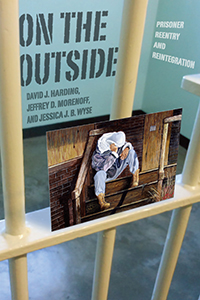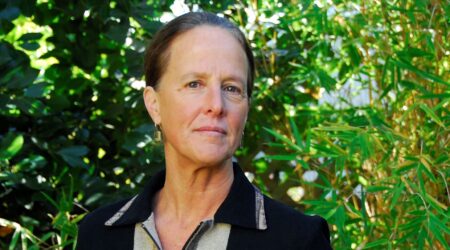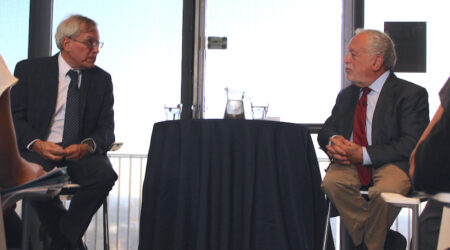America’s high incarceration rates are a well-known facet of contemporary political conversations. Mentioned far less often is what happens to the nearly 700,000 former prisoners who rejoin society each year. Published in 2019 by the University of Chicago Press, On the Outside: Prisoner Reentry and Reintegration (ontheoutsidebook.us) — co-authored by David J. Harding, Professor of Sociology at UC Berkeley, Jeffrey D. Morenoff, Professor of Sociology at the University of Michigan, and Jessica J. B. Wyse, Research Assistant Professor in the Health Systems Management and Policy programs at the OHSU-PSU School of Public Health — examines the lives of twenty-two people as they pass out of the prison gates and back into the world. The book takes a clear-eyed look at the challenges faced by formerly incarcerated citizens as they try to find work, housing, and stable communities. Standing alongside these individual portraits is a quantitative study conducted by the authors that followed every state prisoner in Michigan who was released on parole in 2003 (roughly 11,000 individuals) for the next seven years, providing a comprehensive view of their post-prison neighborhoods, families, employment, and contact with the parole system.
We interviewed Professor David Harding to learn more about the book and the researchers’ key findings and policy recommendations. (Note that responses have been lightly edited).
What led you to this research topic?
For a long time, scholars have known that mass incarceration is an important driver of inequality, and the U.S. is a real outlier in terms of the number of people we put in prison and jail. We researched the consequences of that for the people who experience it — the inmates — and for their families and communities. When we started the project, not much was known about the process of coming out of prison and reintegrating back into society. How do people rebuild their social networks? How do they look for jobs? How do they find housing? How do they meet their basic needs for food? Do they get connected to institutions, like churches? Do they get reengaged in political and civic life?
About half of people who come out of prison end up back in prison within three years. So if we’re going to reduce that recidivism rate, we need to better understand what happens to people when they come out of prison, the challenges they face, and how some are able to overcome those challenges and succeed despite the odds against them, while others struggle and eventually end up back in prison. We think that’s not just a question of preventing crime, but really understanding, how do people come back into society and reintegrate themselves into society, their families, their communities, their neighborhoods? How do they become regular citizens? We think that if people are successful at that, then they’ll be able to to stay away from the types of troubles they’ve had in the past.
What was your methodological approach?
Our research has two main components. The book mostly features the data we collected from in-depth, longitudinal interviews with 22 people — 15 men, seven women — who went through the process of coming out of prison and reintegrating back into Michigan communities. They left Michigan prisons and went to Michigan communities. We interviewed them in prison before they were released to understand what their plans and expectations and hopes and fears were. Then we interviewed them regularly over the next three years to learn about their experiences day to day as they were creating new lives for themselves.
In addition, we also collected data on everyone who left prison in Michigan in 2003, using administrative data from the Michigan Department of Corrections, unemployment insurance agencies, and the state police. From those data, we collected all sorts of information about where they were living, who they were living with, and what jobs they were able to find. Those data provide a statistical portrait of what was happening generally with with reentry and reintegration, and then the qualitative data complemented that by helping us to understand why we see those particular patterns.
What were some of the key findings?
One thing the book does is document how difficult it is to come out of prison and rebuild your life. Many people had trouble even meeting their basic needs for food and shelter. They struggled to find stable housing. They struggled to reconnect with family members. They struggled with addiction. We found that the people who were most successful often were those who had the most family support. Now, most families tried hard to support their loved one as they were coming out of prison, but not all families had the same resources to do so. The ones who were able to really create new lives for themselves could rely on families for social networks, to find new jobs, to have the stability of a residence and food while they found job training or education or just looked for a stable job. Others had to scrape by day to day and could never quite make headway, even if their families were providing them with a place to live.
One of the other arguments in the book is that it doesn’t make sense to really think of the problems of reintegration as simply the problems of the individuals who are coming out of prison. Yes, they tend to have low levels of education and higher rates of mental health problems, particularly addictions, relative to the rest of the population. And that’s a big part of their struggle. But at the same time, it’s important to understand the context and institutions that they encounter when they leave prison. They returned to mostly high-poverty neighborhoods. They returned to a low-skilled labor market where jobs are few, unstable, and low paying. They return to a criminal justice environment where parole is focused on surveillance, monitoring, and punishment. So in a sense, the current era of mass incarceration is one that really enhances the challenges of prisoner reentry and reintegration.
What can be done about this challenge?
Our first recommendation is, given how hard it is for people who are coming out of prison to rebuild their lives, should we be sending them to prison in the first place? Should we be putting people through this, given there’s no real evidence that prison is rehabilitative? And in fact, there’s some evidence that it makes it harder for people to stay away from crime once they’ve been to prison.
If there were fewer people in prison, then we could reinvest those dollars both in preventing the types of problems that lead people to prison and also helping people who are coming out of prison to rebuild their lives. One way we could do that is to really help the people who are helping them the most, and provide families who are doing the work of re-integrating their family members with some support in that process — with housing, food, and so on.
We also need to give people a better access to drug and alcohol treatment. Very few people in our study who had addiction problems ever received the normal recommended amount of residential drug treatment, which is three months. That was incredibly rare. They often had a week or two when they got into some sort of trouble, and then were back out on their own again, just going to an NA and AA meetings and things like that.
We could also change the way we operate parole, the system that supervises people after they’ve come out of prison. The current parole system is really focused on monitoring people, especially around drugs and alcohol or curfew violations. Parole has moved away in the last few decades, in the era of mass incarceration, from actually providing people with any social support and social services as they try to rebuild their lives. We found a huge problem, for example, with people having unstable housing, and those who didn’t have a stable place to live had a very hard time either finding or keeping a job. So if we could provide people with stable housing for the first three to six months, or even a year after they’re released — give them an economic foundation on which to rebuild their lives and start investing in their future — that would go a long way toward solving some of these problems.
Were there any surprises as you were doing this research?
One thing that was surprising was how rarely people went back to the communities where they lived before prison. We often think of this churning in and out of prison, where people go to prison and they come back to the place where they were before, get back into trouble, and end up back in prison again. That’s not what we saw. In fact, less than a third of people ever went back to the same communities where they lived before prison. As they’re rebuilding their lives, they’re rebuilding their lives in new places. Sometimes their family members have moved to a new place, but oftentimes they’re actually intentionally avoiding those places or they’re living in some sort of institutional housing that is not anywhere near those places. So the process of rebuilding one’s life is really starting over from scratch, with a new social network. That was really surprising.
Another surprise from the perspective of prior research is that, while certainly the stigma of having a criminal record was very important in the challenge of finding employment, we also found that a critical problem was maintaining employment once it was found. People would often find a job despite their records, often by applying for lots and lots of jobs, but would have trouble keeping those jobs. That was sometimes because of transportation issues, sometimes it was mental health problems, and sometimes it was just the nature of the low-skilled labor market in America today, where jobs are high-turnover jobs for everybody, particularly those who come with the particular disadvantages that former prisoners do.
What is different about this book compared to prior studies?
On the Outside is one of the first academic studies that’s a large-scale, mixed-methods study of the experience of prisoner reentry and reintegration, including the day-to-day experiences of the people who experience it. And the statistical analysis gives us the broad landscape, the big picture of what’s happening. From an academic perspective, the book is going to be important to people who study the criminal justice system and its impact on American communities, particularly communities of color and poor communities, because it shows the ways in which being involved in the criminal justice system after prison affects people’s outcomes, what they can accomplish, and how they can rebuild their lives. It’s also going to be important to scholars of inequality who think that mass incarceration is playing a big role in equality, because it lays out some of the processes by which people who experience imprisonment and parole and criminal justice, as well as how those experiences affect them and their longer-term outcomes.
One of the things we’re really trying to do in this book is tell the stories of the people who are coming out of prison from their perspective, in their own words, as they told those stories to us. There are six “focal participants” in the research, whose stories are introduced early on and then reappear throughout the book. By seeing those stories and the day-to-day experiences of those individuals — the challenges they went through, the successes they had — you really get a feel for what this experience of re-integration is really like. We’re really trying to humanize the people who are experiencing reentry and reintegration, in contrast to the public dialogue, which tends to demonize people who have a criminal record or have been to prison.
The book also lays out what what the core challenges are: having an economic foundation to build on, finding stable work, and reconnecting with family. That leads to a set of of policy recommendations about specific things we can do to improve prisoner reintegration and, in the longer term, reduce recidivism, and be able to take some of that money that we’re spending on prisons and invest in more in communities and families.



